
LOADING ...
In response to evolving domestic opinion, eMedals Inc has made the conscious decision to remove the presentation of German Third Reich historical artifacts from our online catalogue. For three decades, eMedals Inc has made an effort to preserve history in all its forms. As historians and researchers, we have managed sensitive articles and materials with the greatest of care and respect for their past and present social context. We acknowledge the growing sentiments put forth by the Canadian public and have taken proactive actions to address this opinion.
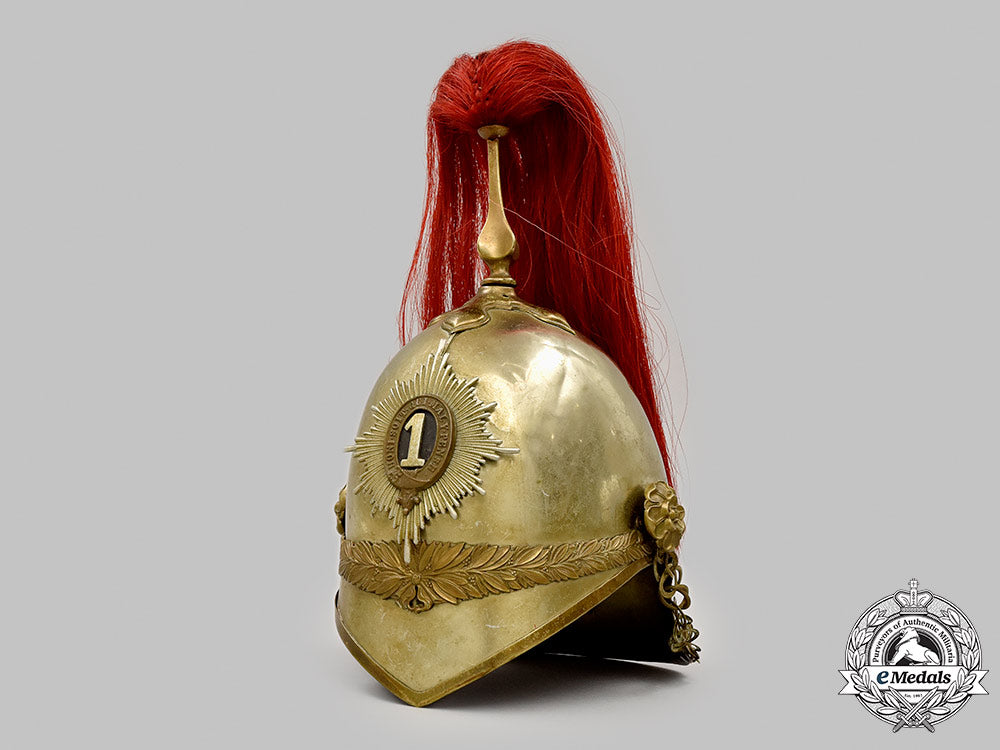
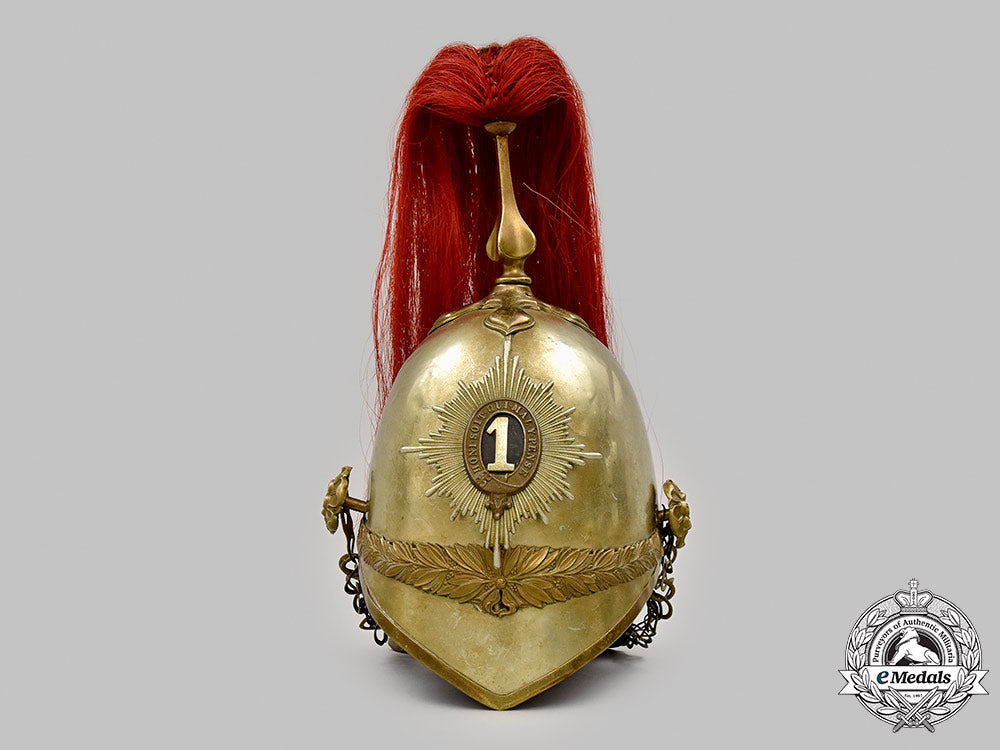
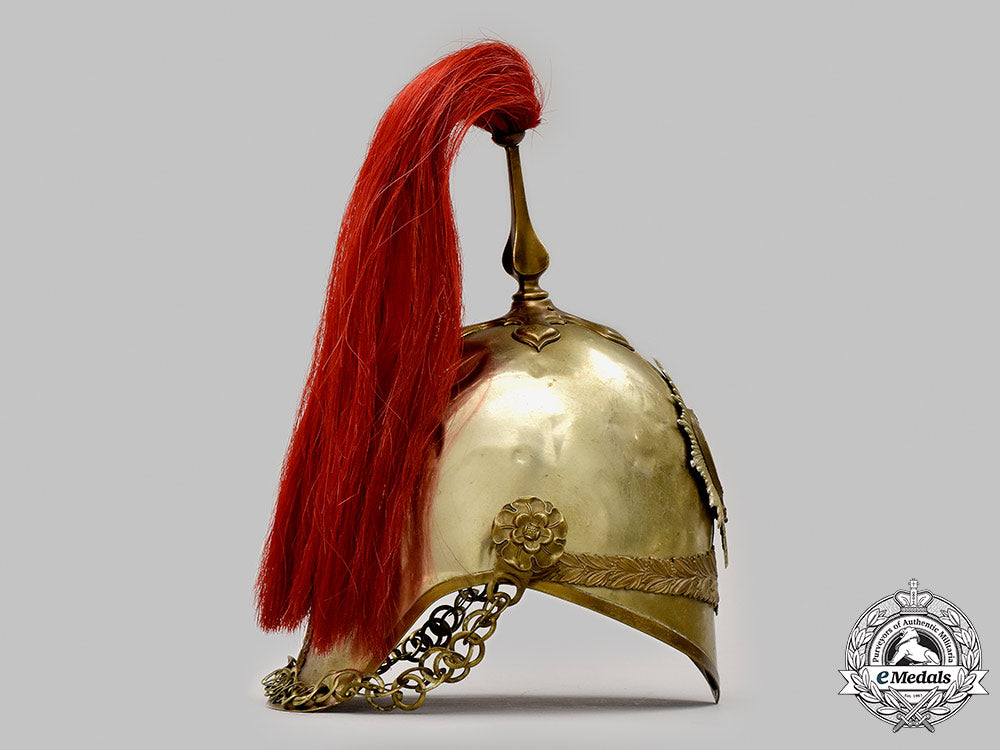
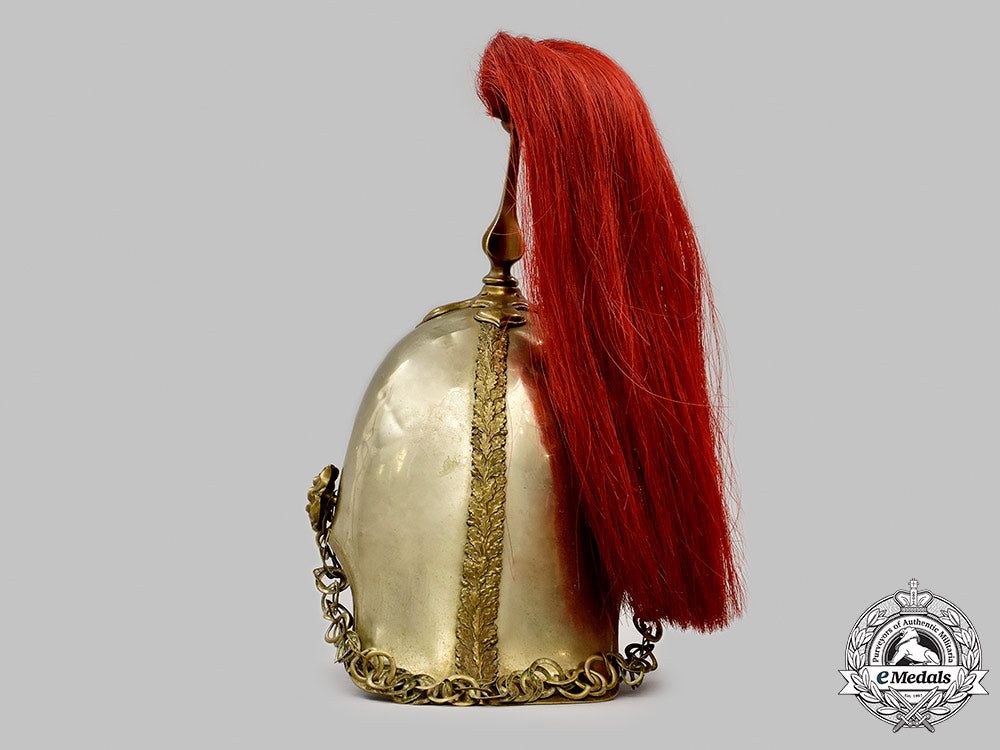
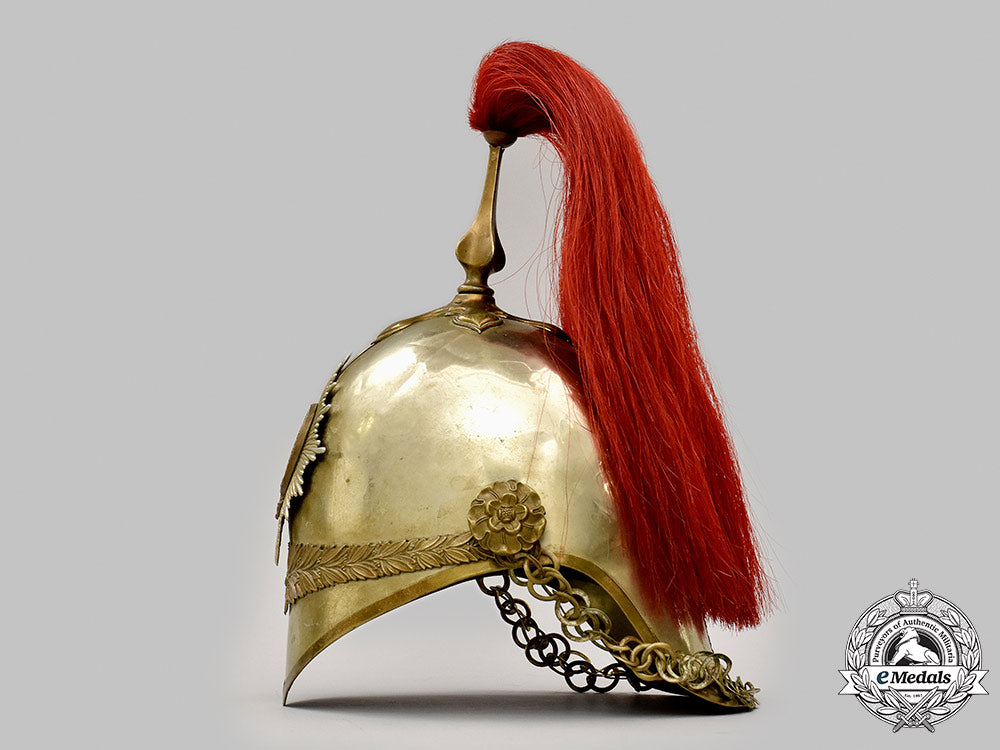
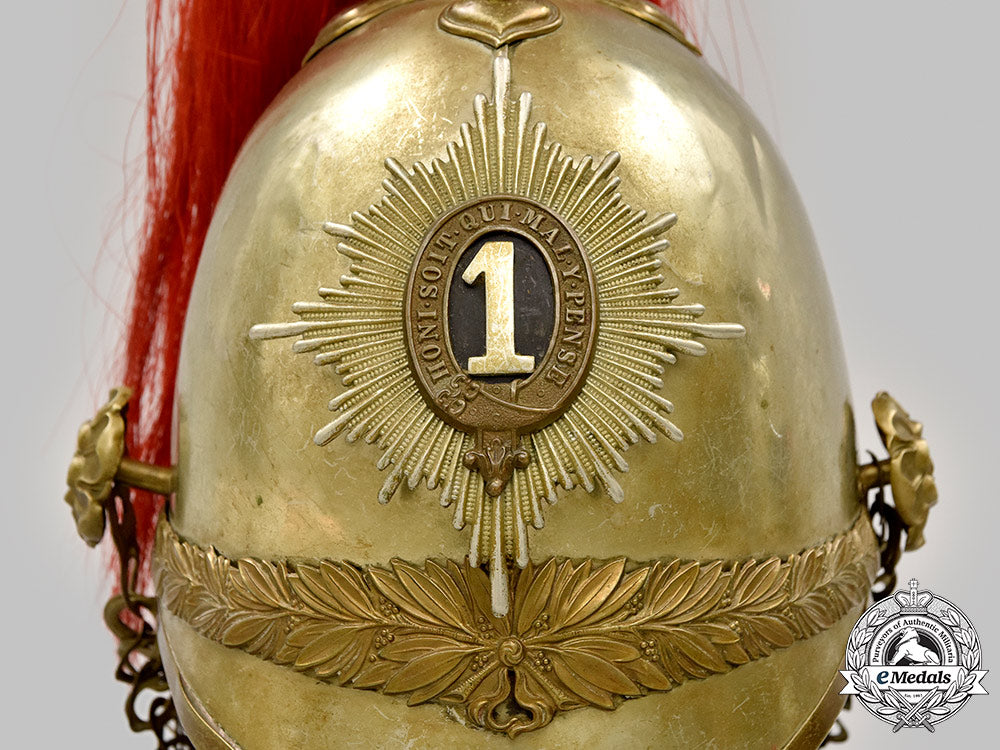
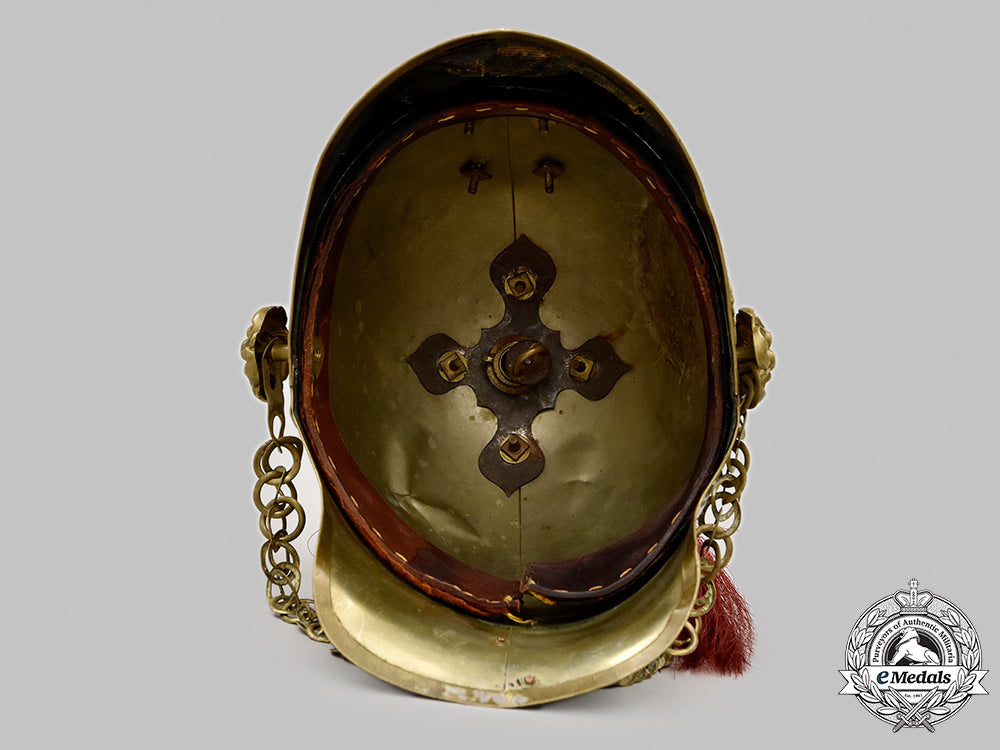
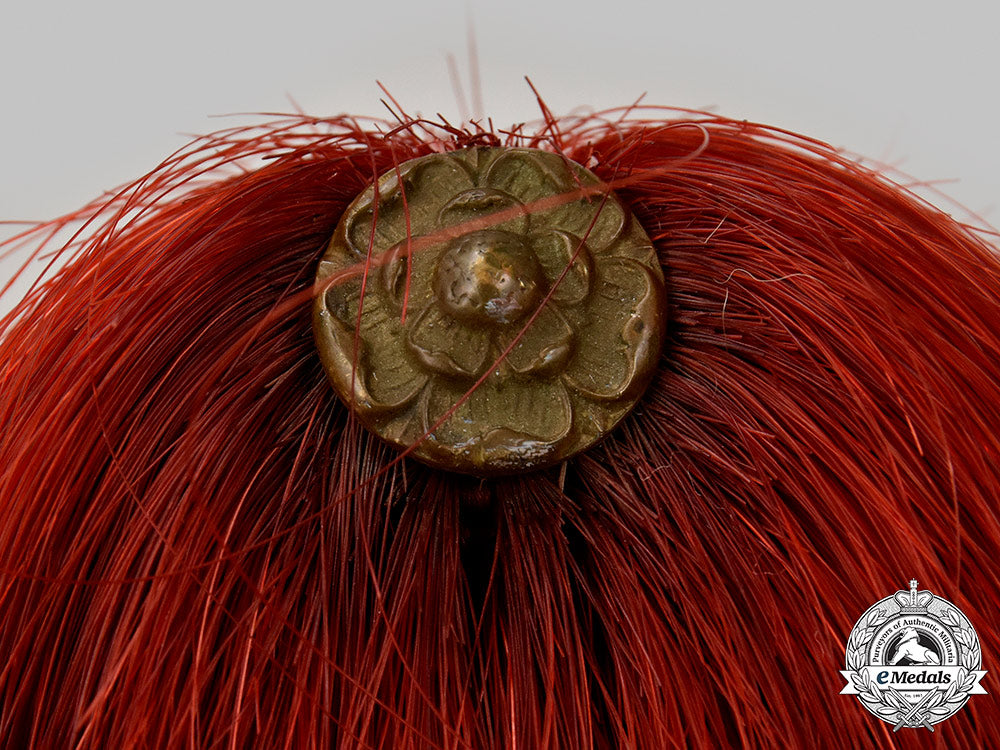
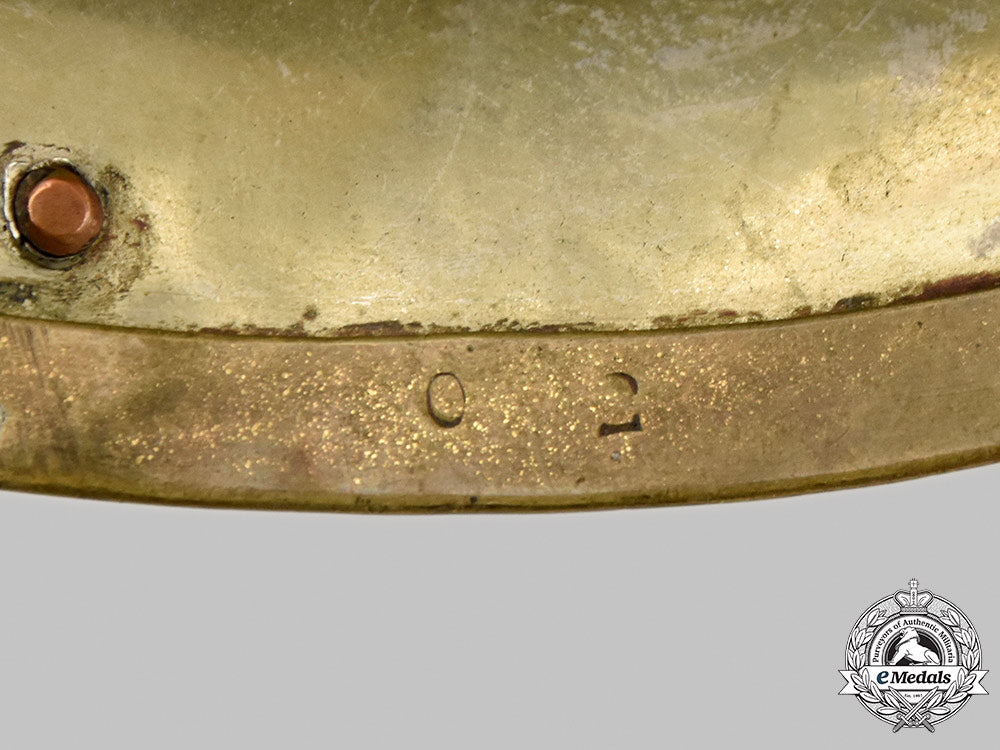
United Kingdom. A 1871 Pattern Victorian 1St King's Dragoon Guards Heavy Cavalry Helmet
United Kingdom. A 1871 Pattern Victorian 1St King's Dragoon Guards Heavy Cavalry Helmet
SKU: ITEM: GB7467
Current Bid:
Your Max Bid:
Bid History:
Time Remaining:
Couldn't load pickup availability
Shipping Details
Shipping Details
eMedals offers rapid domestic and international shipping. Orders received prior to 12:00pm (EST) will be shipped on the same business day.* Orders placed on Canadian Federal holidays will be dispatched the subsequent business day. Courier tracking numbers are provided for all shipments. All items purchased from eMedals can be returned for a full monetary refund or merchandise credit, providing the criteria presented in our Terms & Conditions are met. *Please note that the addition of a COA may impact dispatch time.
Shipping Details
eMedals offers rapid domestic and international shipping. Orders received prior to 12:00pm (EST) will be shipped on the same business day.* Orders placed on Canadian Federal holidays will be dispatched the subsequent business day. Courier tracking numbers are provided for all shipments. All items purchased from eMedals can be returned for a full monetary refund or merchandise credit, providing the criteria presented in our Terms & Conditions are met. *Please note that the addition of a COA may impact dispatch time.
Description
Description
The shell of the helmet is fabricated from two pieces of non-magnetic silvered metal alloy forming the dome, along with a third piece of silvered metal alloy creating the protruding point at the front, designed with a "lobster tail" at the rear. The raw open edge of the metal alloy helmet has a brass protective strip, forming a lip around the entire opening. The rear seam between the two halves is concealed by a band in brass that displays a continuous cluster of oak leaves, the band travelling from the spike base to the brass protective strip at the rear and secured in place by a series of copper pins.
There is a large helmet plate on the front, the type of which has been worn on the helmet beginning in 1842. The helmet plate has a four-piece construction, the insignia bearing a large numeral "1" in silvered brass, the numeral centred on a black re-painted background, framed by a bronze gilt garter inscribed "HONI SOIT QUI MAL Y PENSE" (a Middle French maxim, meaning "shamed be whoever thinks bad of it", usually translated as "shame on anyone who thinks evil of it" and used as the motto of the British chivalric Order of the Garter). The insignia is placed upon a white metal twelve-pointed star, the four larger star points with seven emanating rays, the eight smaller star points with five emanating rays, the plate secured in place via four screwposts, each with a nut, the helmet plate measuring 107 mm in width x 125 in height.
The conjoined chin scales (chin chains) are in brass and form a chinstrap, but are missing their protective leather backer. The chin scales are attached on either side to brass ear rosettes, each of which is mounted in place to a screwpost that is fed through the body of the helmet and the leather headband, then secured in place by a large brass plate and two copper rivets on the inside of the helmet. The front band resting just below the helmet plate conceals the seam that is formed by the butting of the two halves of the dome, the band in brass and consists of clusters of laurel leaves, running between the ear rosettes and secured in place by copper pins.
The large brass spike protruding from the body of the helmet houses a holder for the red horsehair plume, the top of the spike finished with a brass rosette. The spike is held in place on the inside of the helmet by a large metal and brass post and screw combination with a u-shaped grip, however, the spike remains loose versus the body of the helmet. The brass base of the spike has four distinct points, all of which are flush to the body of the helmet, with a magnetic metal plate on the underside that bears the same shape as that used on the base, the plate secured in place via four screwposts, each with a washer and nut combination.
The inside has a thick and wide dark brown leather headband, stitched in place to a second thinner piece of leather that acts as a buffer between the headband and the sidewall of the helmet, secured in place by the same large brass plate and two copper rivets that are used to secure the ear rosettes. The underside at the protruding point at the front between the leather headband and the opening maintains its original thin black finished leather lining, however, the helmet is missing its leather liner. It is stamped with a "0" and a "2" at the right rear on the brass protective strip, however, it appears that a possible museum acquisition code may have been erased immediately to the left of these numerals.
The helmet measures 210 mm in width x 250 mm in depth x 315 mm in height, the exterior exhibiting a large dent at the right rear, with a series of smaller dents appearing at the left front and rear, with scuffing and surface wear evident overall, the aforementioned spike loose versus the body of the helmet, the chin scales missing their protective leather backer and the liner missing on the interior. Fine.
Footnote: The 1st King's Dragoon Guards was a cavalry regiment in the British Army. The regiment was raised by Sir John Lanier in 1685 as Lanier's Regiment of Horse or the 2nd Queen's Regiment of Horse, named in honour of Queen Mary, consort of King James II, as part of the response to the Monmouth Rebellion. The regiment saw action at the Battle of the Boyne in July 1690 and the Battle of Aughrim in July 1691 during the Williamite War in Ireland. It also fought at the Battle of Blenheim in August 1704, the Battle of Ramillies in May 1706, the Battle of Oudenarde in July 1708 and the Battle of Malplaquet in September 1709 during the War of the Spanish Succession. The regiment was renamed the 2nd King's Own Regiment of Horse in 1714 in honour of King George I. It saw action again at the Battle of Dettingen in June 1743 during the War of the Austrian Succession.
The regiment was renamed the 1st King's Dragoon Guards in 1751. The regiment made a desperate charge which saved the army at the Battle of Corbach in July 1760 and then made another famous charge at the Battle of Warburg later that month during the Seven Years' War. The regiment charged again with devastating effect at the Battle of Waterloo in June 1815 during the Napoleonic Wars. The regiment took part in the response to the Indian Rebellion in 1857, as well as the Battle of Taku Forts in August 1860 and the capture of Peking during the Second Opium War. A detachment of the regiment was responsible for the capture of King Cetshwayo at the Battle of Ulundi in July 1879 during the Anglo-Zulu War and the regiment saw action again at the Battle of Laing's Nek in January 1881 during the First Boer War. The regiment was employed chasing the elusive General Christiaan de Wet in the spring of 1901 during the Second Boer War.
In March 1896, Emperor Franz Joseph I of Austria became Colonel-in-Chief of the regiment. At the same time the double-headed Austrian eagle became the cap badge of the regiment, and it adopted Radetzky March as its regimental march. On the occasion of his Diamond Jubilee on December 2, 1908, the Emperor instituted the Inhaber-Jubiläums-Medaille für Ausländer (Commander's Jubilee Medal for Foreigners) to celebrate his sixty years on the throne. Some of the 40 golden, 635 silver and 2,000 bronze medals were awarded to officers and private soldiers in the regiment. The ceremonial helmet with the badge of the 1st King's Dragoon Guards which was given to Emperor Franz Joseph I on his appointment as colonel-in-chief is now on display at the Museum of Military History, Vienna.
During the First World War, the regiment, which had been stationed at Lucknow in India at the start of the war, landed at Marseille as part of the 8th (Lucknow) Cavalry Brigade in the 1st Indian Cavalry Division in November 1914 for service on the Western Front. The regiment saw action at the Battle of Festubert in May 1915, the Second Battle of Ypres also in May 1915 and the Battle of Morval in September 1916 but returned to India in October 1917.
The regiment remained in garrison at Meerut until October 1918 when it exchanged stations with the 21st (Empress of India's) Lancers and moved to Risalpur. On May 2, 1919, Afghan troops seized control of wells on the Indian side of the border. The Afghan Amir Amanullah was warned to withdraw, but his answer was to send more troops to reinforce those at the wells and to move other Afghan units to various points on the frontier. The regiment was mobilised on May 6th and formed part of the British Indian Army's 1st (Risalpur) Cavalry Brigade. It served throughout the Third Anglo-Afghan War and saw action at the Khyber Pass. At Dakka, a village in Afghan territory, north west of the Khyber Pass, on May 16th, the regiment made one of the last recorded charges by a British horsed cavalry regiment, as it was already apparent the old world would be giving way to mechanisation.
During the Second World War, the regiment took part in all the major battles of the North African Campaign including the Relief of Tobruk in November 1941. The regiment, then serving as the armoured car reconnaissance regiment of Lieutenant General Richard McCreery's X Corps, landed at Salerno during the Allied invasion of Italy in September 1943 against concentrated enemy opposition and were the first Allied unit into the city of Naples in early October 1943. The Welsh writer Norman Lewis, in his celebrated account of life in Naples claimed that the King's Dragoon Guards was the first British unit to reach Naples in 1943, and that many of its officers immediately went on a looting spree, cutting paintings from their frames in the prince's palace. The regiment later took part in the Battle for Monte la Difensa in December 1943 and the advance to the Gothic Line in late 1944.
The regiment was posted to Palestine in September 1945 and to Libya in January 1947 before being deployed on home duties at Omagh, Northern Ireland in February 1948. The regiment moved to Adams Barracks in Rahlstedt in November 1951 and to Mcleod Barracks in Neumünster in April 1953. In 1956, the regiment was sent on active service in Malaya during the Malayan Emergency. During this time, the regiment took part in counter-insurgency operations in both mounted operations (armoured cars) and on foot in the dense jungles operating from a base at Johor Bahru. The regiment merged with the Queen's Bays (2nd Dragoon Guards) in 1959, to form the 1st The Queen's Dragoon Guards.
Description
The shell of the helmet is fabricated from two pieces of non-magnetic silvered metal alloy forming the dome, along with a third piece of silvered metal alloy creating the protruding point at the front, designed with a "lobster tail" at the rear. The raw open edge of the metal alloy helmet has a brass protective strip, forming a lip around the entire opening. The rear seam between the two halves is concealed by a band in brass that displays a continuous cluster of oak leaves, the band travelling from the spike base to the brass protective strip at the rear and secured in place by a series of copper pins.
There is a large helmet plate on the front, the type of which has been worn on the helmet beginning in 1842. The helmet plate has a four-piece construction, the insignia bearing a large numeral "1" in silvered brass, the numeral centred on a black re-painted background, framed by a bronze gilt garter inscribed "HONI SOIT QUI MAL Y PENSE" (a Middle French maxim, meaning "shamed be whoever thinks bad of it", usually translated as "shame on anyone who thinks evil of it" and used as the motto of the British chivalric Order of the Garter). The insignia is placed upon a white metal twelve-pointed star, the four larger star points with seven emanating rays, the eight smaller star points with five emanating rays, the plate secured in place via four screwposts, each with a nut, the helmet plate measuring 107 mm in width x 125 in height.
The conjoined chin scales (chin chains) are in brass and form a chinstrap, but are missing their protective leather backer. The chin scales are attached on either side to brass ear rosettes, each of which is mounted in place to a screwpost that is fed through the body of the helmet and the leather headband, then secured in place by a large brass plate and two copper rivets on the inside of the helmet. The front band resting just below the helmet plate conceals the seam that is formed by the butting of the two halves of the dome, the band in brass and consists of clusters of laurel leaves, running between the ear rosettes and secured in place by copper pins.
The large brass spike protruding from the body of the helmet houses a holder for the red horsehair plume, the top of the spike finished with a brass rosette. The spike is held in place on the inside of the helmet by a large metal and brass post and screw combination with a u-shaped grip, however, the spike remains loose versus the body of the helmet. The brass base of the spike has four distinct points, all of which are flush to the body of the helmet, with a magnetic metal plate on the underside that bears the same shape as that used on the base, the plate secured in place via four screwposts, each with a washer and nut combination.
The inside has a thick and wide dark brown leather headband, stitched in place to a second thinner piece of leather that acts as a buffer between the headband and the sidewall of the helmet, secured in place by the same large brass plate and two copper rivets that are used to secure the ear rosettes. The underside at the protruding point at the front between the leather headband and the opening maintains its original thin black finished leather lining, however, the helmet is missing its leather liner. It is stamped with a "0" and a "2" at the right rear on the brass protective strip, however, it appears that a possible museum acquisition code may have been erased immediately to the left of these numerals.
The helmet measures 210 mm in width x 250 mm in depth x 315 mm in height, the exterior exhibiting a large dent at the right rear, with a series of smaller dents appearing at the left front and rear, with scuffing and surface wear evident overall, the aforementioned spike loose versus the body of the helmet, the chin scales missing their protective leather backer and the liner missing on the interior. Fine.
Footnote: The 1st King's Dragoon Guards was a cavalry regiment in the British Army. The regiment was raised by Sir John Lanier in 1685 as Lanier's Regiment of Horse or the 2nd Queen's Regiment of Horse, named in honour of Queen Mary, consort of King James II, as part of the response to the Monmouth Rebellion. The regiment saw action at the Battle of the Boyne in July 1690 and the Battle of Aughrim in July 1691 during the Williamite War in Ireland. It also fought at the Battle of Blenheim in August 1704, the Battle of Ramillies in May 1706, the Battle of Oudenarde in July 1708 and the Battle of Malplaquet in September 1709 during the War of the Spanish Succession. The regiment was renamed the 2nd King's Own Regiment of Horse in 1714 in honour of King George I. It saw action again at the Battle of Dettingen in June 1743 during the War of the Austrian Succession.
The regiment was renamed the 1st King's Dragoon Guards in 1751. The regiment made a desperate charge which saved the army at the Battle of Corbach in July 1760 and then made another famous charge at the Battle of Warburg later that month during the Seven Years' War. The regiment charged again with devastating effect at the Battle of Waterloo in June 1815 during the Napoleonic Wars. The regiment took part in the response to the Indian Rebellion in 1857, as well as the Battle of Taku Forts in August 1860 and the capture of Peking during the Second Opium War. A detachment of the regiment was responsible for the capture of King Cetshwayo at the Battle of Ulundi in July 1879 during the Anglo-Zulu War and the regiment saw action again at the Battle of Laing's Nek in January 1881 during the First Boer War. The regiment was employed chasing the elusive General Christiaan de Wet in the spring of 1901 during the Second Boer War.
In March 1896, Emperor Franz Joseph I of Austria became Colonel-in-Chief of the regiment. At the same time the double-headed Austrian eagle became the cap badge of the regiment, and it adopted Radetzky March as its regimental march. On the occasion of his Diamond Jubilee on December 2, 1908, the Emperor instituted the Inhaber-Jubiläums-Medaille für Ausländer (Commander's Jubilee Medal for Foreigners) to celebrate his sixty years on the throne. Some of the 40 golden, 635 silver and 2,000 bronze medals were awarded to officers and private soldiers in the regiment. The ceremonial helmet with the badge of the 1st King's Dragoon Guards which was given to Emperor Franz Joseph I on his appointment as colonel-in-chief is now on display at the Museum of Military History, Vienna.
During the First World War, the regiment, which had been stationed at Lucknow in India at the start of the war, landed at Marseille as part of the 8th (Lucknow) Cavalry Brigade in the 1st Indian Cavalry Division in November 1914 for service on the Western Front. The regiment saw action at the Battle of Festubert in May 1915, the Second Battle of Ypres also in May 1915 and the Battle of Morval in September 1916 but returned to India in October 1917.
The regiment remained in garrison at Meerut until October 1918 when it exchanged stations with the 21st (Empress of India's) Lancers and moved to Risalpur. On May 2, 1919, Afghan troops seized control of wells on the Indian side of the border. The Afghan Amir Amanullah was warned to withdraw, but his answer was to send more troops to reinforce those at the wells and to move other Afghan units to various points on the frontier. The regiment was mobilised on May 6th and formed part of the British Indian Army's 1st (Risalpur) Cavalry Brigade. It served throughout the Third Anglo-Afghan War and saw action at the Khyber Pass. At Dakka, a village in Afghan territory, north west of the Khyber Pass, on May 16th, the regiment made one of the last recorded charges by a British horsed cavalry regiment, as it was already apparent the old world would be giving way to mechanisation.
During the Second World War, the regiment took part in all the major battles of the North African Campaign including the Relief of Tobruk in November 1941. The regiment, then serving as the armoured car reconnaissance regiment of Lieutenant General Richard McCreery's X Corps, landed at Salerno during the Allied invasion of Italy in September 1943 against concentrated enemy opposition and were the first Allied unit into the city of Naples in early October 1943. The Welsh writer Norman Lewis, in his celebrated account of life in Naples claimed that the King's Dragoon Guards was the first British unit to reach Naples in 1943, and that many of its officers immediately went on a looting spree, cutting paintings from their frames in the prince's palace. The regiment later took part in the Battle for Monte la Difensa in December 1943 and the advance to the Gothic Line in late 1944.
The regiment was posted to Palestine in September 1945 and to Libya in January 1947 before being deployed on home duties at Omagh, Northern Ireland in February 1948. The regiment moved to Adams Barracks in Rahlstedt in November 1951 and to Mcleod Barracks in Neumünster in April 1953. In 1956, the regiment was sent on active service in Malaya during the Malayan Emergency. During this time, the regiment took part in counter-insurgency operations in both mounted operations (armoured cars) and on foot in the dense jungles operating from a base at Johor Bahru. The regiment merged with the Queen's Bays (2nd Dragoon Guards) in 1959, to form the 1st The Queen's Dragoon Guards.









You May Also Like
Germany, HJ. A 1938 National Trade Competition Victor’s Badge, Gold Grade in Case, By Gustav Brehmer
G60096
Italy, Republic. An Order of Merit of the Italian Republic, Grand Cross Set by Johnson, 1970
EU23677
Spain, Franco Period. An Order of Civil Merit, Grand Cross Set
EU23731
Russia, Imperial. An Order of St. Anne, II Class in Gold
EU23720
Austria, Imperial. An Order of the Iron Crown, III Class in Gold, by Rothe, c.1900
EU23723
-
Germany, HJ. A 1938 National Trade Competition Victor’s Badge, Gold Grade in Case, By Gustav Brehmer
G60096
Add to CartRegular price $3,950 USDRegular price $0 USD Sale price $3,950 USDUnit price / per -
Italy, Republic. An Order of Merit of the Italian Republic, Grand Cross Set by Johnson, 1970
EU23677
Add to CartRegular price $950 USDRegular price $0 USD Sale price $950 USDUnit price / per -
Spain, Franco Period. An Order of Civil Merit, Grand Cross Set
EU23731
Add to CartRegular price $600 USDRegular price $0 USD Sale price $600 USDUnit price / per -
Russia, Imperial. An Order of St. Anne, II Class in Gold
EU23720
Add to CartRegular price $2,950 USDRegular price $0 USD Sale price $2,950 USDUnit price / per -
Austria, Imperial. An Order of the Iron Crown, III Class in Gold, by Rothe, c.1900
EU23723
Add to CartRegular price $3,950 USDRegular price $0 USD Sale price $3,950 USDUnit price / per
Do you have a similar item you are interested in selling?
Please complete the form and our client care representatives will contact you.
Sell Item






















